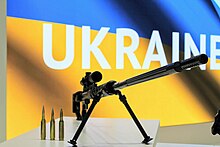Longest recorded sniper kills
[5][6][7][8][9] Although optical equipment such as rangefinders and ballistic calculators have largely eliminated manual calculations to determine elevation and windage, the fundamentals of accurate and precise long-range shooting remain essentially the same since the early history of shooting, and the skill and training of the shooter, and the shooter's spotter where applicable, are the primary factors.Accuracy and precision of ammunition and firearms are also still reliant primarily on human factors and attention to detail in the complex process of producing maximum performance.[10] Any given combination of firearm and ammunition will have an associated value, known as the circular error probable (CEP), defined as the radius of a circle whose boundary is expected to contain the impact points of half of the rounds fired.[citation needed] The longest confirmed kill in World War II was by German sniper Matthäus Hetzenauer at 1,100 metres (1,200 yd).[citation needed] After returning to the US, Hathcock helped to establish the Marine Corps Scout Sniper School at Quantico, Virginia.Even after being severely burned during an attack on an Amtrac on which he was riding in his efforts to rescue other Marines, which earned him a Silver Star, and after being diagnosed with multiple sclerosis, Hathcock continued to serve, shoot and instruct.[20] Harrison killed the two Taliban machine gunners with shots that took the 8.59 mm (0.338 inch) rounds almost five seconds to hit their targets, which were 900 m (980 yd) beyond the L115A3 sniper rifle's recommended range.



Royal MarinesAccuracy International L115A1Craig HarrisonSchmidt & BenderballisticSecurity Service of UkraineRussian invasion of UkraineMcMillan TAC-50Canadian ArmyRob Furlongelevationwindageaccurate and precisetrajectory and point of impactair densityCoriolis effectcircular error probablelaser rangefindersMatthäus HetzenauerVietnam WarCarlos HathcockScout SniperQuantico, VirginiaAmtracmultiple sclerosisArron PerryPrincess Patricia's Canadian Light InfantryOperation AnacondaWar in AfghanistanHorizon's LordCorporal of HorseBlues and RoyalsAccuracy InternationalJoint Task Force 2Iraqi Civil Warnecking12.7×114 mm HL wildcatUkraineSpecial Group "Alpha".50 BMGCanadaCANSOFCOMCanadian Armed ForcesWar in IraqBarrett M82A1Raufoss Mk 211Australia2nd Commando RegimentSOCOMDAustralian Defence ForceSnipex Alligator14.5×114mmUkrainian National GuardMinistry of Internal AffairsAccuracy International L115A3.338 Lapua MagnumUnited KingdomHousehold CavalryBritish ArmyUnited States2nd Battalion75th Ranger RegimentUnited States ArmyIraq War7th Marine Regiment1st Marine DivisionUnited States Marine CorpsDenel NTW-14.5South AfricaSouth African Special Forces BrigadeJoint Operations DivisionMONUSCOSpecialist91st Cavalry RegimentChris KyleSEAL Team 3US Naval Special Warfare CommandUnited States NavyThe Black Watch (3 SCOT)Royal Regiment of ScotlandSaudi ArabiaRoyal Saudi Land ForcesArmed Forces of Saudi ArabiaYemeni Civil WarBarrett M82A32nd Marine RegimentBilly DixonSharps .50-90.50-90 SharpsAmerican Indian WarsNorwayNorwegian ArmySergeantDragunov SVD7.62×54mmR 7N1Soviet Union345th Independent Guards Airborne RegimentSoviet ArmySoviet–Afghan War509th Parachute Infantry RegimentM1903 Springfield.30-06 SpringfieldAmerican Expeditionary ForcesWorld War IM24 Sniper Weapon System7.62×51 mm NATO69th Armor Regimentmatch gradeList of snipersLong range shootingThe Daily TelegraphFriscolanti, MichaelMaclean'sDaily NewsSunday TimesAl ArabiyaUniversity of Toronto PressSightline Media GroupUnited States Armed ForcesCharleston CourierEvening Public LedgerCyrus H. K. CurtisThe Globe and MailABC-CLIOVolksbladThe Sunday Telegraph